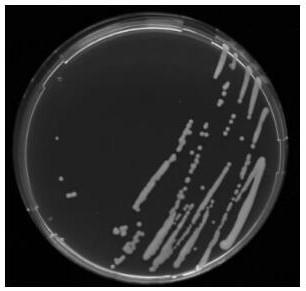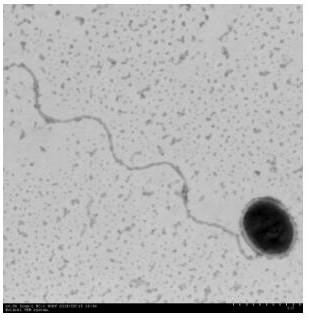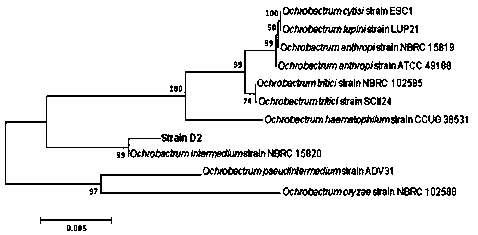N-acyl high serine lactone quenching bacterium and application thereof in disease control
A quenching and bacterial strain technology, which is applied in N-acyl homoserine lactone quenching bacteria and its application in disease prevention and control, can solve the problems of acyl side chain length and saturation difference, and reduce the problem of pesticide abuse Effect
- Summary
- Abstract
- Description
- Claims
- Application Information
AI Technical Summary
Problems solved by technology
Method used
Image
Examples
Embodiment 1
[0047] Example 1 Acquisition and Identification of Paleobacterium intermedium Strain D-2
[0048] 1. Isolation and screening of strain D-2
[0049] (1) Soil sample collection: soil samples collected from power plants in Hebei Province as microbial sources
[0050] Soil samples were collected from the power plant in Hebei Province on August 9, 2017. Sampling, bagging, and preservation were carried out as microbial sources and brought back to the school for strain isolation.
[0051] (2) Enrichment culture of strains: prepare basic salt (MSM) medium, put 20 mL of MSM medium into a 250 mL Erlenmeyer flask for sterilization, add OHHL mother solution under sterile conditions after cooling (acetonitrile as solvent) , so that the final concentration of OHHL was 5 μM, and 5 g of soil samples were added at the same time. After culturing for 7 days at 30 °C and 200 rpm, the inoculum was transferred to the second batch of MSM culture containing 10 μM OHHL Base. After culturing under t...
Embodiment 2
[0072] Antibiotic susceptibility analysis of embodiment 2 bacterial strain D-2
[0073] In order to better study the biocontrol potential of the bacterial strain D-2 obtained in Example 1, we conducted in-depth research on the biological characteristics of the bacterial strain. The sensitivity of strain D-2 to different antibiotics was experimentally studied, as Figure 4 shown.
[0074] The experimental results showed that the resistance of the strain D-2 to ampicillin reached 400 μg·mL -1 Above, the resistance to kanamycin reaches 350 μg·mL -1 , the resistance to gentamicin and streptomycin reached 40 μg·mL -1 , the resistance to chloramphenicol reached 10 μg·mL -1 , no resistance to tetracycline. This result is helpful for selecting appropriate antibiotics as a reference in follow-up studies.
Embodiment 3
[0075] Example 3 Analysis of strain D-2 substrate spectrum
[0076] 1. Strain culture and sample collection:
[0077] Under the condition of 30 ℃, the strain D-2 was activated on the LB solid plate. Pick a single colony and inoculate it into LB liquid medium, and culture overnight at 30 °C and 200 rpm to obtain a bacterial liquid. Take a certain volume (V=1 / OD 600 ) was centrifuged at 4000 rpm for 10 min, and the supernatant was discarded to obtain an OD 600 value bacteria. Will 1 OD 600 Value of the bacteria, inoculated into 1mL MSM inorganic salt medium with different AHLs as the sole carbon source. The reaction mixtures were placed in 2 mL centrifuge tubes, and the centrifuge tubes were incubated at 30 °C and 200 rpm for 24 h. After 24 h, take 5 μL of the reaction mixture and spot it on the top of a 1 cm wide MM agar strip, and then spot the reporter strain CF11 ( Agrobacterium tumefaciens NT1) bacteria solution. Then place the agar strips with the reaction mixture...
PUM
 Login to View More
Login to View More Abstract
Description
Claims
Application Information
 Login to View More
Login to View More - R&D
- Intellectual Property
- Life Sciences
- Materials
- Tech Scout
- Unparalleled Data Quality
- Higher Quality Content
- 60% Fewer Hallucinations
Browse by: Latest US Patents, China's latest patents, Technical Efficacy Thesaurus, Application Domain, Technology Topic, Popular Technical Reports.
© 2025 PatSnap. All rights reserved.Legal|Privacy policy|Modern Slavery Act Transparency Statement|Sitemap|About US| Contact US: help@patsnap.com



